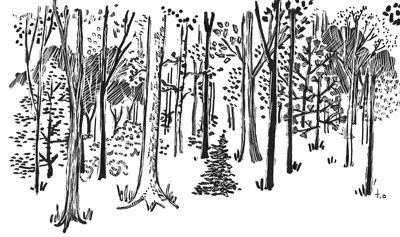Low-Impact Forestry
What is the Low-Impact Forestry Program?
The Low-Impact Forestry (LIF) program at MOFGA is a group of loggers, foresters, landowners, farmers and interested persons educating about, practicing and advocating for ecologically-based and economically-sound forest practices. We practice and endorse forestry that seeks to reduce the known harmful impacts of logging, and promote the social and ecological benefits. The LIF program hosts workshops year-round covering all sorts of forestry related topics from logging with draft animals to home firewood production. The LIF staff also participates in collaborative logging projects that explore creative forest management and contracts that benefit both landowner and logger.

The 9 Principles of Low-Impact Forestry
1. LIF recognizes that forest ecosystems are more complex than we currently understand, and therefore operates thoughtfully with caution and humility as first principles
2. LIF believes that wood products can be grown and harvested in a way that maintains the other ecosystem services that fully functioning forests provide
3. LIF requires that harvesting operations minimize damage to unharvested trees, soils, and water quality
4. LIF promotes growing and harvesting durable, long-lasting and high-value forest products
5. LIF recognizes the value of forests as a climate change mitigation tool and promotes carbon sequestration and storage as an important goal of forest management
6. LIF incorporates climate change adaptation and resilience strategies in forest management plans, forest roads and trails, recreational and other activities, and harvests
7. LIF considers forest management on a multi-generational timescale
8. LIF believes that managed multi-aged forests with late-successional characteristics, large-diameter trees, and high stocking should be more common on the landscape
9. LIF promotes payment structures that allow land managers and forest practitioners to do careful work while making a sustainable living
Workshops and Events
The Low-Impact Forestry program hosts seminars and workshops for all skill levels and interests. For a complete listing of upcoming LIF events and registration information please visit the LIF Trainings page.
Featured Videos
Playlist
Featured Articles
Managing a Maine Woodland to Maximize Carbon Sequestration
By Denny Gallaudet – March 2020 I have the good fortune to be the owner of a 25 acre woodland in Southern Maine. Abandoned as a pasture in the late 1930’s, it is now a flourishing and well stocked forest of the oak-pine variety. In 2016 I conducted a timber inventory and found that carbon
American Beech
A beech tree severely affected by beech bark disease. Postharvest view of a gap created during winter 2020 firewood cutting. Slash has been cut small and will decompose over the next few years; think of it as fertilizer for the next generation of trees. First flush of shiitake mushrooms on beech logs after a spring rain
Cost of Carelessness in the Woodlot
Heavy damage done to a red oak during harvest (conducted by a different owner). The entire butt log is ruined, and decay likely extends higher than shown here. 1988 Tree Farmer C5D – a mid-sized cable skidder The pine tree discussed here, eight months after being damaged. By Noah Gleason-Hart Photos by the author Low-impact forestry’s guiding
Adapting Your Woodlot to a Changing Climate Assisted Migration
Current climate change projections predict that Maine will become increasingly hospitable to red oak. English photo Red oak acorns. English photo By Noah Gleason-Hart As Hannah Murray outlined in her winter 2018 article in The MOF&G, with foresight, planning and commitment, our forests have a large role to play in mitigating the effects of climate
To Cut or Not to Cut Is That the Question
Large diameter cavity trees provide bird habitat, enhancing the overall value of a forest. English photo By Noah Gleason-Hart When the topic of forestry or land management comes up, the first question people often ask is, “Should I my cut my woodlot?” or, “Is my land due for a harvest?” It’s a daunting question with huge implications.
Crop Tree Management Managing for Value Not Volume
A red oak crop tree with double flagging surrounded by competing red maple, oak lacking quality and diseased beech (not pictured) marked to be cut. Crown view of the same red oak crop tree. Note the crown competition and lack of available growing space. “The crop tree crown in the center of this illustration has been





